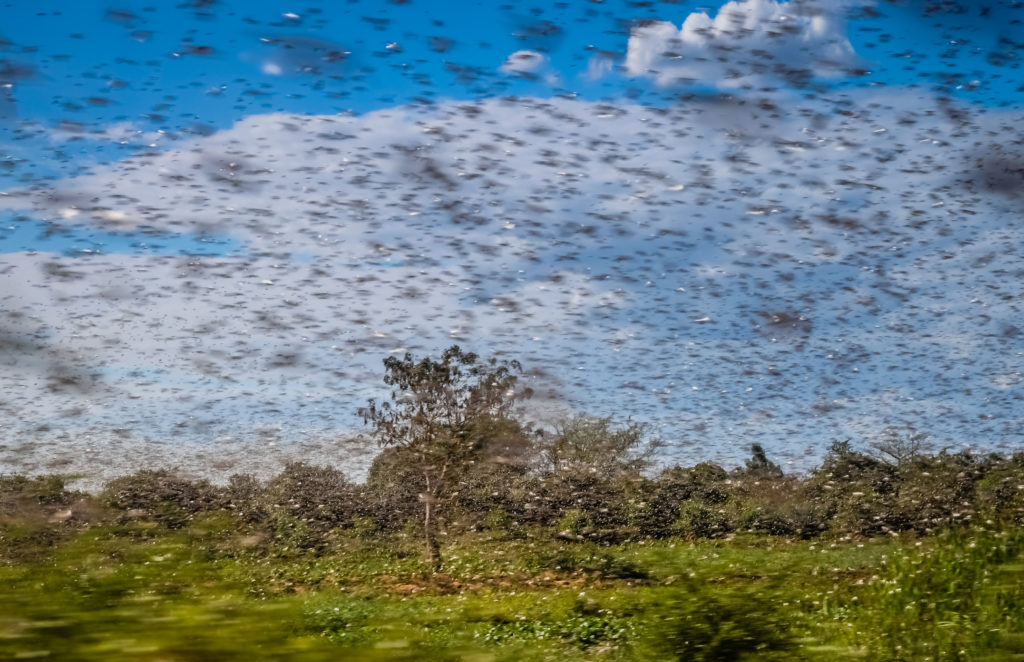In the midst of a global pandemic, East Africa and West Asia are grappling with a devastating locust plague.
Desert locusts are a part of the grasshopper family and are migratory. What makes them so destructive is the fact that they feast on crops and travel in massive swarms according to the U.N. Food and Agriculture Organization, or FAO. While their lifespan is only three months, under the right conditions, they can multiply up to twentyfold in just one generation.
The locusts have made their way to Kenya, Ethiopia, Somalia, and Djibouti. With the changing winds, they are expected to head towards Sudan. The last locust outbreak in Kenya took place 70 years ago, while Uganda last witnessed locusts 60 years ago. One of the biggest fears is that the locusts could easily move even farther into West Africa and dominate some of the poorest countries in the world. In recent weeks, the insects have invaded India and Pakistan, specifically the Punjab and Sindh provinces.
“This is the worst transboundary pest in the world,” Melissa Williams, a senior rural development specialist for the World Bank, said. “They don’t need passports, so they’ll just keep going.”
Despite the invasion, some progress has been made in the fight to eradicate the scary bugs.
“It’s about 450 billion insects that we killed since the beginning of the year,” Cyril Ferrand, head of the FAO’s resilience team in East Africa, said of estimates that more than 1.1 million acres were brought under control by the FAO and the various governments.
Despite the coronavirus pandemic, those involved in assisting with the locusts were exempt from the quarantine rules.
“That’s to the credit of governments, which elevated desert locusts to a national priority,” Ferrand said. “So, despite the curfew and the restriction of movement of people, all our field staff are able to move.”
The World Bank announced $500 million in aid, as well as private and international organizations who are also donating to the cause.⠀⠀⠀⠀⠀⠀⠀⠀
Drones are being used to monitor and deploy small doses of pesticides in hard-to-reach areas of Kenya. Satellite imagery of Ethiopia, captured by the European Space Agency, was used to track when locusts were detected compared with the destruction left behind.
Extensive on-the-ground monitoring of the insects is also responsible for this intensified spraying.
“Only when you have identified targets, you can send the plane to spray,” Ferrand said.
The most effective method to control the locusts is spraying pesticides. Countries such as Eritrea and Sudan, which are accustomed to the creatures, already have strong eradication methods in place to keep the insect’s numbers down.
However, in other areas where eradication methods were not regularly practiced, such as Yemen, which did not have pesticide spraying taking place in 2018, heavy rain and two cyclones from the Indian Ocean created lush vegetation for the locusts to thrive and rapidly multiply.
“Normally, the first line of defense is Yemen,” Williams said. But “the funds aren’t there, and it’s very difficult to access, because you’re crossing lines of conflict, and so things got out of control.”
One of the main concerns is that the swarms will leave many people starving. According to the FAO, a 1-kilometer swarm can consume as much food as 35,000 people in a single day.
There are over 20 million people across the Horn of Africa that already have insufficient access to food, according to the FAO. Dreary worst-case projections predict that another 5 million people could experience starvation if the locusts are not controlled.

 Baller Alert Entertainment & Lifestyle
Baller Alert Entertainment & Lifestyle




